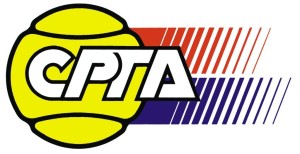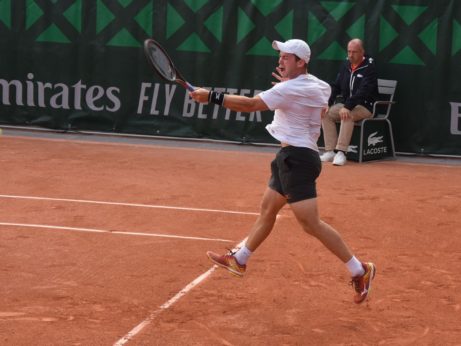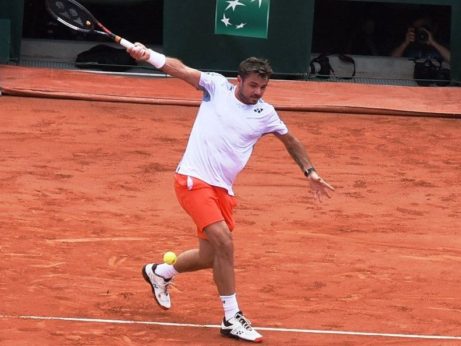Xiyu Wang – Mistake-prone aggressive forehand
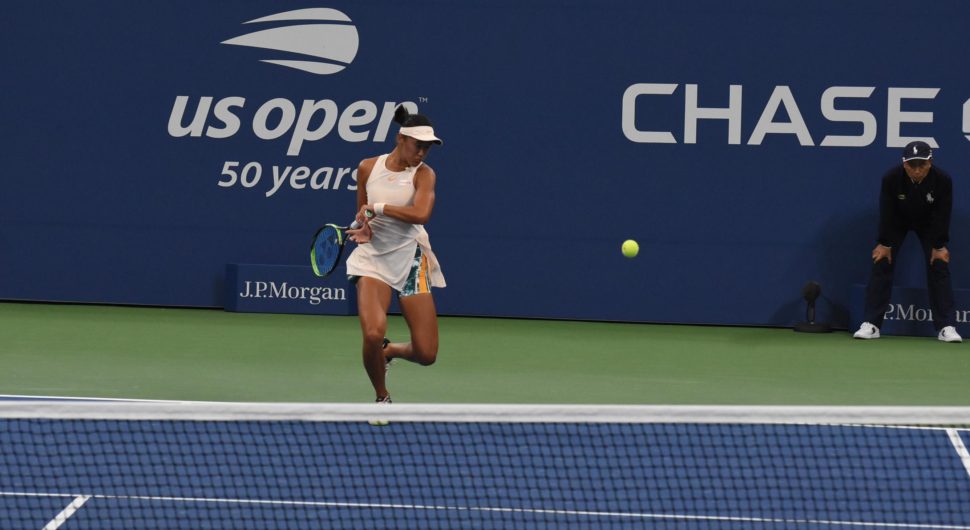
Tall Chinese leftie Xiyu Wang (*2001 / CHN) is an upcoming young player with tremendous potential. Just a few days ago, she captured in New York the 2018 US Open Junior Girls’ title (finals win against Burel/FRA) and this, together with her other excellent junior results, brought her onto the position of the #1 at the ITF Junior Girls’ ranking (as of September 10, 2018). Besides that, she has won two titles at the ITF Future events in the US$ 25’000 category this past summer as well already and this helped her to the current top 250 WTA ranking.
Wang has an almost ideal tennis body with long extremities. For her age, she has already quite highly developed tactical playing varieties and is well capable of an attacking all-court game, which she applied quite successfully also during her recent US Open campaign. Her overall tactical possibilities are then in my opinion slightly limited by certain technical weaknesses in her strokes. In this article, I would like to look at her forehand. Wang is playing her forehand in a very aggressive manner, but this stroke is prone to rather frequent mistakes, mainly due to the quite clearly visible overactivity in the elbow, which is often limiting the possibility of an ideal body energy unloading and thus leading to both limited power and reduced control of the stroke. This weakness is then quite typical with many, mainly young players, who are missing the proper understanding of the ideal helix form of the Tennis 3.0 strokes, which are becoming more and more to the decisive benchmark at the top levels of the game. For Wang, figuring out the ideal helix form of her forehand with its optimal “3 Step Tennis Stroke Regulation” might be one of the ultimate tasks on her way to the potential tennis greatness.
The photos below document the mentioned forehand troubles, as seen during the finals match in New York on the first Sunday in September 2018. It is well visible that Wang’s elbow is often staying very close to her body during the active part of the follow through (= follow through 1). This signals that the rotational body energy is not the all-dominant driving force behind the strokes shown. The desired way of striking (the image of the stroke in the brain) is then in general very closely (subconsciously) connected to the spacing and vice versa. Such forehand as shown here can do reasonably well when the pressure from the opponent is rather limited, but it can become a certain liability when the big pressure of the top players will come along and when the most efficient strokes with limited margin will be needed. Besides the limited power output, potential problems are then in the area of the ball receiving (incoming ball power absorption) as well as in the stroke precision under the pressure as more elbow flexing activity goes hand in hand with a reduced margin control and higher stroke volatility.
On the bottom is also small documentation of the above-mentioned problem from Wang’s lost three-set match during the 2017 French Open Junior Championships (against Andreescu/CAN).
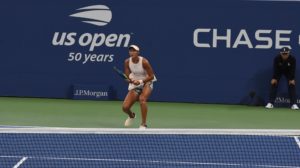
Xiyu Wang (*2001 / CHN) – Forehand as the 3rd stroke in a match – 1 of 8 – split-step after a successful service – good eye focus at the return action of the opponent – 2018 US Open Juniors – New York / USA – September 2018

Xiyu Wang (*2001 / CHN) – Forehand as the 3rd stroke in a match – 2 of 8 – initial pivot – beginning – powerful outside leg loading, good focus – 2018 US Open Juniors – New York / USA – September 2018

Xiyu Wang (*2001 / CHN) – Forehand in a match – 3 of 8 – stepping-in with the inside leg (=direct stance) while creating a rather limited space for the stroke = suboptimal 1st step of the “3 Step Tennis Stroke Regulation” – 2018 US Open Juniors – New York / USA – September 2018
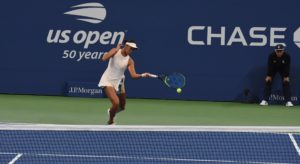
Xiyu Wang (*2001 / CHN) – Forehand in a match – 4 of 8 – moments after the impact – excellent eye control of the impact zone but limited body energy involvement – rotation of the body doesn’t seem to “run the show” to the fullest possible extend – 2018 US Open Juniors – New York / USA – September 2018

Xiyu Wang (*2001 / CHN) – Forehand in a match – 5 of 8 – end of follow through 1 – elbow is staying very close to the body – elbow flexion and forearm pronation dominate the stroke – body energy unloading into the stroke and thus also the control of the racket in the space are rather quite limited – 2018 US Open Juniors – New York / USA – September 2018
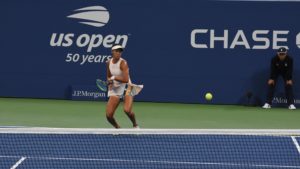
Xiyu Wang (*2001 / CHN) – Forehand in a match – 6 of 8 – follow through 2 – relaxation, combined with the approach initiation – 2018 US Open Juniors – New York / USA – September 2018
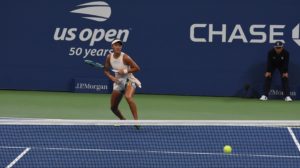
Xiyu Wang (*2001 / CHN) – Forehand in a match – 7 of 8 – further continuation of the approach initiation, the ball just played is having a very little margin over the net – 2018 US Open Juniors – New York / USA – September 2018

Xiyu Wang (*2001 / CHN) – Forehand in a match – 8 of 8 – approach to the net – one of Wang’s standard patterns – service cross-court followed by the 3rd stroke down the line as attacking/approach stroke – 2018 US Open Juniors – New York / USA – September 2018
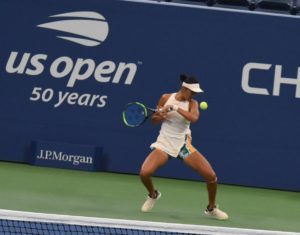
Xiyu Wang (*2001 / CHN) – Forehand in a match – 1 of 2 – end of follow through 1 – open stance – elbow stays very close to the body – both body energy unloading, as well as stroke precision, have been compromised, excellent very long eye control of the impact zone – 2018 US Open Juniors – New York / USA – September 2018

Xiyu Wang (*2001 / CHN) – Forehand in a match – 2 of 2 – follow through 2 aka relaxation with a good body balance, but from this image showing an excellent body rotation is it not possible to recognize what happened before as shown above – 2018 US Open Juniors – New York / USA – September 2018
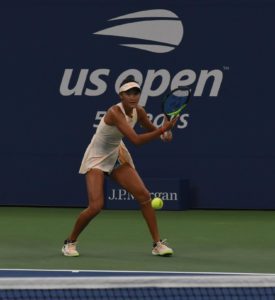
Xiyu Wang (*2001 / CHN) – Forehand in a match – 1 of 8 – initiation of the pivot – open stance – excellent ball observation – 2018 US Open Juniors – New York / USA – September 2018
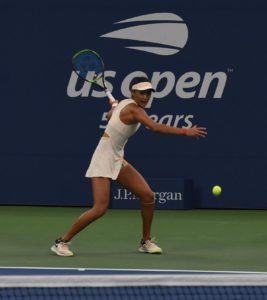
Xiyu Wang (*2001 / CHN) – Forehand in a match – 2 of 8 – full take-back with the outside leg loading, good use of the non-dominant arm, perfect head stability – 2018 US Open Juniors – New York / USA – September 2018
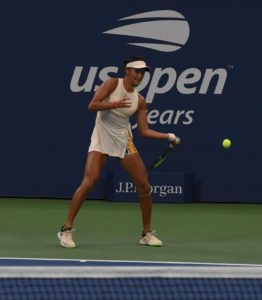
Xiyu Wang (*2001 / CHN) – Forehand in a match – 3 of 8 – initiation of the forward swing or rather start of the unloading process, good eye control of the impact zone – 2018 US Open Juniors – New York / USA – September 2018
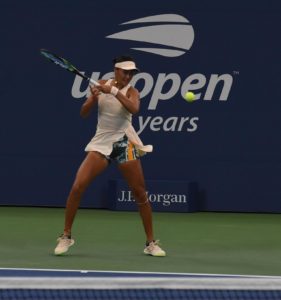
Xiyu Wang (*2001 / CHN) – Forehand in a match – 4 of 8 – follow through 1 – elbow stays close to the body – body energy unloading is limited, good head/eye stability – 2018 US Open Juniors – New York / USA – September 2018
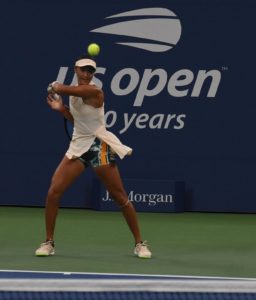
Xiyu Wang (*2001 / CHN) – Forehand in a match – 5 of 8 – end of follow through 1 with excellent body balance/stability – from this photo here is it also almost impossible to see the problems, which can be seen on the previous photo – 2018 US Open Juniors – New York / USA – September 2018
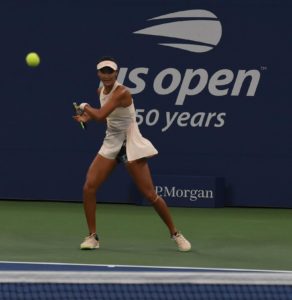
Xiyu Wang (*2001 / CHN) – Forehand in a match – 6 of 8 – follow through 2 aka relaxation beginning – 2018 US Open Juniors – New York / USA – September 2018

Xiyu Wang (*2001 / CHN) – Forehand in a match – 7 of 8 – relaxation while observing the ball path as well as the action of the opponent – 2018 US Open Juniors – New York / USA – September 2018
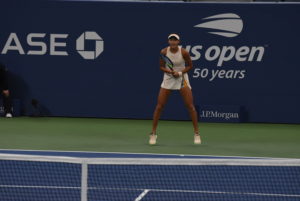
Xiyu Wang (*2001 / CHN) – Forehand in a match – 8 of 8 – split-step timed to the action of the opponent – 2018 US Open Juniors – New York / USA – September 2018
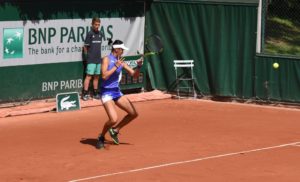
Xiyu Wang (*2001 / CHN) – Forehand in a match – 1 of 1 – follow through 1 – elbow flexion dominates the stroke, body energy is being held back – 2017 French Open Juniors – Paris / France – June 2017
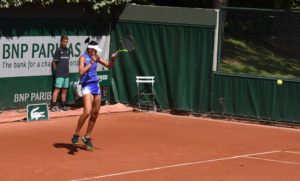
Xiyu Wang (*2001 / CHN) – Forehand in a match – 1 of 1 – follow through 1 – elbow flexion dominates the stroke, pronation is not involved yet – 2017 French Open Juniors – Paris / France – June 2017

Xiyu Wang (*2001 / CHN) – Forehand in a match – 1 of 2 – follow through 1 – end – strong dominance of the elbow activity, body energy influence is limited – 2017 French Open Juniors – Paris / France – June 2017

Xiyu Wang (*2001 / CHN) – Forehand in a match – 2 of 2 – follow through 2 -aka relaxation – this photo also doesn’t well show the limitation of the body energy involvement, which can be well seen on the photo above – 2017 French Open Juniors – Paris / France – June 2017
This article covers certain aspects of Xiyu Wang’s forehand and forehand in general only! Further extensive photo galleries and more details (inclusive improvement possibilities/suggestions) about her forehand and other strokes as well as about the strokes of other players are available upon request at drmgb11(at)gmail.com. Some significant details of this kind, necessary for a peak tennis performance as well as for a sustainable tennis training/development in general, are being discussed also in the seminar “TENNIS 3.0 – Future of the Game”, which is available worldwide upon request – www.tennis30.com / www.tennis30.cz
Photos (September 2018 & June 2017) & text (September 2018) copyright by Dr. Martin G. Baroch. Any further publication of either any of the photos and/or texts with the explicit written permission issued by the author/copyright owner only!! All instruction provided reflects just the personal opinion of the author and neither the author nor the CPTA accepts any responsibility for potential damages, direct or implied, of any kind!!
